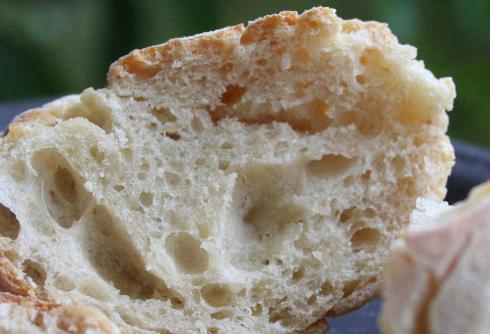I’m stealing again, this time from Sandor Katz and his fabulous florescent book, Wild Fermentation. Katz suggests that bread yeast grows more obligingly without salt to slow things down, and that makes sense. I’ve now mixed up two batches of long rise artisan bread dough sans salt. Both looked quite happy and bubbly after their overnight rise, as though this was middle of summer and not the coldest month on record.

The trick would be getting salt added before baking, and I opted to knead the grains in on the second morning. Which brings us to the next item, kneading. Borrowing again from Katz, I worked a bit of additional flour into my dough at the same time I added salt, to give the yeast a little snack. (My dough tends to come out pretty wet, so the extra flour firmed things up nicely.) Well. Not only did the loaf rise flawlessly, with none of those icky nubs you can get with homemade bread, but the flavor was also very good. I didn’t sample every single slice, of course, but the bread got eaten. Fast.
The long-rise and five-minute people tell you not to handle your dough too much, and the thinking is that a long rise time allows lots of flavor and gluten to develop. But now I’m wondering whether a good knead or two on subsequent days might not hurt and maybe even helps.
If someone can shed some light on these mysteries, I would like that.

5 comments
Comments feed for this article
December 31, 2008 at 11:40 am
Laura
I’ve found the same thing with the long rise bread options (not the salt part, but that’s cool!) if I knead at least once. I’ve lately been making traditional kneaded artisan bread and am finding that if I’m home for an afternoon or a long morning it’s really not a hard thing to do. Interestingly the recipe I use for that DEFINITELY benefits from more kneading and the extra flour that’s added in that second round.
Nigel Slater claims that it has to do with stretching the gluten.
January 1, 2009 at 1:04 pm
audrey
Laura, good to hear that you are getting results with some kneading. And kneading that makes me feel like I am actually making bread, too.
January 4, 2009 at 9:19 pm
Saara
I still haven’t tried that no knead version opting for alternating between Reinhart and the 5-minute-batter dough, but Reinhart says that stirring your sourdough starter in between refreshing helps since it tends to give the yeastiebeasties some air. So, to explain a bit more, I refresh my sourdough starter in the morning and stir it once at night. Next morning, I’ll add more flour and water to refresh and stir again in the evening. I realize you’re doing bread dough, but along with stretching the gluten it probably does give it some air … maybe?
January 30, 2009 at 9:47 am
poppy
Audrey, a friend is giving me a sourdough starter but after seeing the video with the 5 minute folks, I can’t wait to try their method. Any ideas on combining the two?
January 31, 2009 at 11:24 am
audrey
Saara, great tip on aerating the dough. Thank you.
Poppy, I tried to make my own sourdough starter last month and to incorporate it into a batch of overnight bread dough. My starter was so wet I treated it like the wet ingredient (water) and added just a bit less flour to bring it to the right consistency. The loaves didn’t rise quite as well as I would have hoped, so I’m still tinkering.
Other starters might be more dough like – sometimes I’ll use old dough as a starter – and if that’s the case, I’d make the regular five minute dough, cutting way back on the yeast and mixing in the starter. If you have a sense for the approximate wetness of bread dough, add a bit of flour or water until it comes together as dough but is still very sticky. Let me know how yours goes. Good luck!